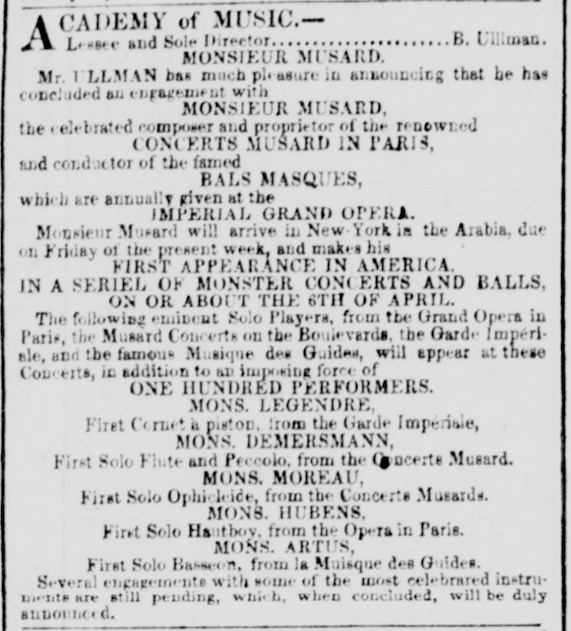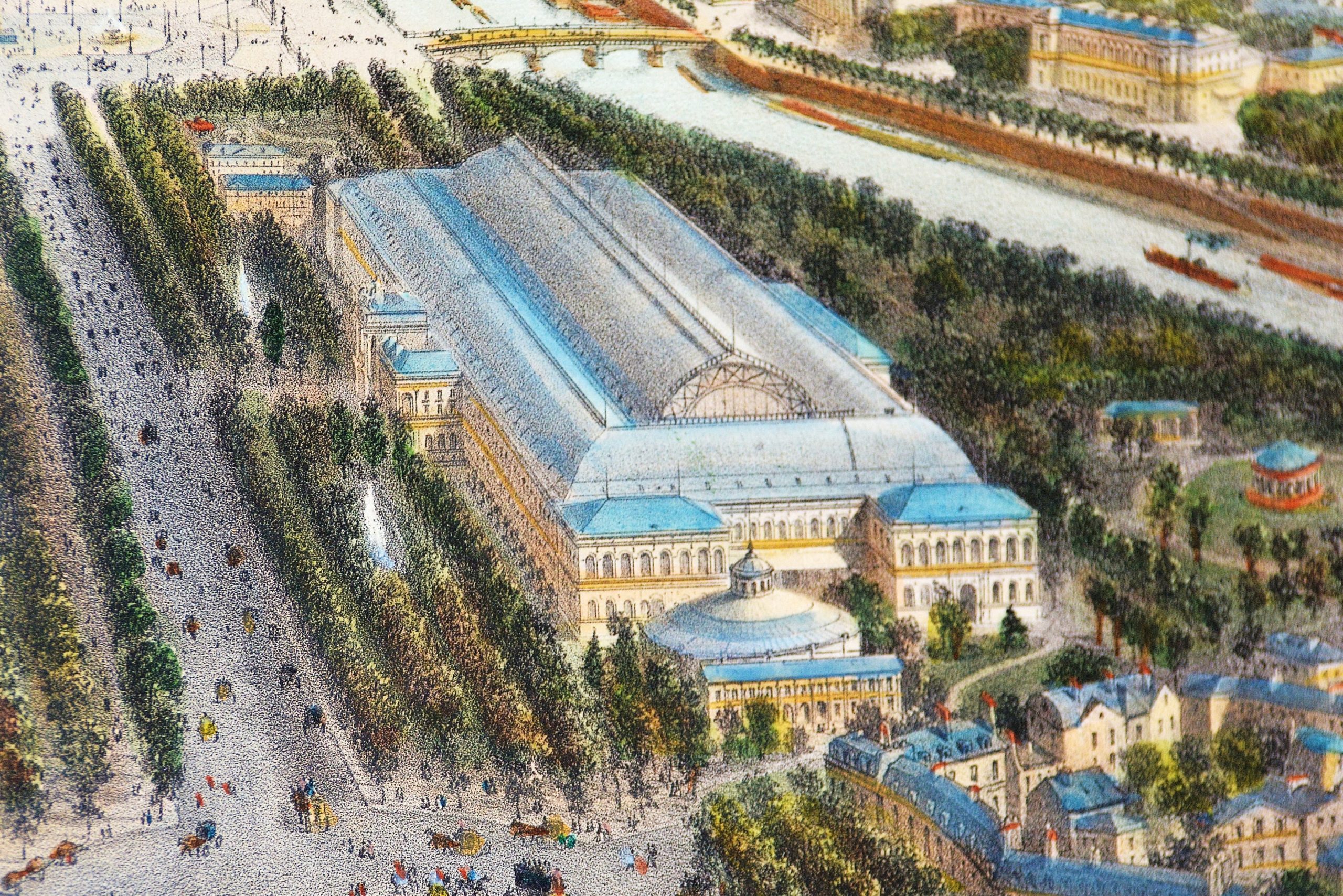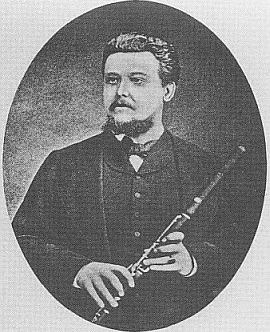1845 – Tulou, 11e Grand Solo
On 8 August 1845 Le Commerce reports: “The sixth session of the public competitions of the students of the Conservatoire de musique et de déclamation was devoted today to the wind instrument competitions. The jury was composed of M. Habeneck, president, and Messrs Carafa, Ambroise Thomas, Dorus, Colet, Mengal, Verroust, Prumier and Ruteux (…) 4th competition: flute; the 1st prize was awarded to M. Demersseman; the 2nd to M. Blanco; M. Couplet obtained an accessit.”
Jules-Auguste-Édouard Demersseman, born in Hondschoote (Nord), on 9 January 1833 into a family of tanners, shows musical talent at an early age. He is sent to Paris at the end of 1844 aged eleven (or twelve) to study with Tulou. Tulou attests him a beautiful tone of the flute, lightness and taste. Demersseman stays in the flute class for only three quarters of a year and immediately wins a first prize in his first concours. This makes him the youngest student to win a first prize between 1824 and 1860. In the same year he also receives a second prize in solfège, followed by a first prize the following year. At thirteen, Demersseman is still too young for an orchestral post. Perhaps that is why he (or was it his family?) decided to stay at the Conservatoire and study harmony (1846-49) and later counterpoint and fugue. He finishes harmony without a prize, for counterpoint and fugue he acquires a first accessit in 1852, but also finishes this study without a prize. Demersseman has great ambitions as a composer. In 1854 and 1855 he applies for the Prix de Rome, is one of the six candidates in the final round both times, but ultimately does not win a prize. In 1856 Jacques Offenbach announces a competition for the composition of an operetta. In the 1857 season it will be included in the programme of the Théâtre des Bouffes Parisienne. Demersseman also applies for this, but is beaten by Georges Bizet, then only eighteen years old, and his fellow competitor Charles Lecocq.
In the meantime 24 years old Demersseman earns his living as a flute player. In the years that follow, he plays in various orchestras and concerts, appearing among others in the Société des Jeunes Artistes under the direction of Pasdeloup as a flute player and composer. From 1856 he is a member of the new concert series Concerts Musard founded by the conductor Alfred Musard at the Hôtel d’Osmond. He performs in almost every (almost daily) concert during the concert season, playing in the orchestra as well as soloist with his own compositions, fantaisies or airs variés. The concert programme alternates between solo pieces with various wind and string instruments and lighter fare in the form of quadrilles and overtures. In 1857, the concert series is renamed Concerts de Paris, and the orchestra is now also conducted by the cornetist (cornet à piston) Jean-Baptiste Arban. The concerts are extremely popular with the Parisian public. In summer, they take place in a pavilion in Ranelagh Park near the Bois de Boulogne just outside Paris and attract up to 2000 listeners. They begin at 20h30 and last two and a half hours. At eleven o’clock in the evening, a special train brings guests and musicians back home to the centre of Paris (on that link you find a photograph of the music pavilion probably from around 1900, it might still be the same as 50 years ago)
The audience and critics are enthusiastic about Demersseman. On 12 January 1858, the newspaper Vert-vert writes: “Mr. Demersseman is an incomparable flutist for the finesse of his modulations as well as for the fullness he knows how to give to his instrument when he makes it sing: a very rare quality, and one that belongs only to a true artist to possess, the flute being, when it is badly played, – let us be forgiven the word – a rather thin and rather shrill instrument.” Le Ménestrel reports on 7 November: “Mr Demersseman’s talent triumphs over these impossibilities: breadth and purity of sound, – agility, equality of fingers, – clarity of articulation, – expression, feeling, he has all the qualities of a virtuoso.”
The year 1858 begins with great expectations. In February, Alfred Musard receives a contract for 40,000 francs to stage a concert series at the Acadamy of Music in New York the following season. Musard plans to bring some of his soloists with him, including the cornetist Legendre, the ophicleidist Moreau, the oboist Hubans, bassoonists Artus and Demersseman, in order to have them perform as soloists and to strengthen his monster orchestra, which is founded there. Advertisements appear in New York newspapers (as the following one of the New York Daily Tribune from 18 March) announcing their coming.

In the end, only Legendre and Moreau accompany Musard to America, Demersseman remains in Paris. He continues to perform at the Concerts de Paris and composes a symphony which is premiered in October. In January 1860, Pasdeloup programmes it in his concert series. Unfortunately, the symphony has not survived. Music critics differ in their opinion of the new composition. To some, its style reminds them of Beethoven, to others of Haydn. The first movement, Introduction et Allegro, is said to be more of an overture with flute solo than an orchestral movement, the second movement, Andante, seems very well done, the Scherzo does not please everyone, being a complete contrast to the first two movements, but is also described as a coquettish, dapper and elegant little piece. Finally, the finale is a lively piece with a cello melody and pizzicato accompaniment and a short fugato (Le Monde illustré 6 November, Le Ménestrel 7 November 1858, Niederrheinische Musik-Zeitung 18 August 1860).
From the summer of 1858, Victor-Florentin Elbel conducts the orchestra. Elbel conducts it until April 1859, after which the second conductor, oboist Hubans, takes over. At this point, Demersseman leaves the orchestra and Miramont (first prize winner in 1839) takes his place. In the meantime, Musard returned from America and resumed his work as conductor of the orchestra. Now the summer concerts take place in a pavilion on the Champs-Elysées behind the Palais de l’Industrie. The orchestra might have played in the little red pavilion at the right site of the following lithography.

The Palais d’Industrie with its huge park and the little pavilion don’t exist anymore. Today, the Grand Palais stands in its place, and the park had to make way for wide streets.
The concert series can again build on the success of the past and is as popular as before. Demersseman is once again one of the stars of the orchestra. On 3 December 1859, we read in the Journal de Seine-et-Marne: “What can be said of Mr Demersseman’s talent on the flute? It is velocity, lightness, ardour, a splendid string of pearls standing out and rolling in space.”
In 1859 Demersseman composes the operetta La Princesse Kaïka for the théâtre des Folies-Nouvelles. This work, as his symphony, has not survived because, like most of his orchestral works, it was not published. An exception is Une fête à Aranjuez: fantaisie espagnole for orchestra with solo violin(?). This work was still very popular in the early 20th century and was arranged for various instrumentations. In contrast to the orchestral works, his flute works were regularly printed from 1858 onwards. Demersseman was not only played by Demersseman, but by other flute players such as Amédée de Vroye or later Rudolph Tillmetz. From the end of the 19th century, more and more flute players include Demersseman’s works in their programmes. Demersseman not only composes for the flute, but also devotes himself to the new instrument family of his friend Adolphe Sax: from soprano to double-bass saxophone, for cor sax à trois pistons et a tubes indépendants, trombone and trompette sax à six pistons et à tubes indépendants. Some of his works serve as concours works for these instruments.

While Demersseman probably composes during the day, he plays in the evening in the Concerts des Champs-Elysées. In 1863 he performs in a festival in Rochefort. The local newspapers outdo each other in praising the Parisian flute player:
“What incredible and prodigious agility of the fingers and the strokes of the tongue! How he detaches these myriads of notes that flow in a murmur like a stream. – One can distinguish everything, one can hear everything, and under this uninterrupted cadence, the song is heard perfectly clear and distinct. (…) Despite all the seductions of the silver flute, Mr Demersseman has kept the old flute.” (Le Nouvelliste de La Rochelle).
“Many revolutions have transformed the flute, one wanted to give it more brilliance, a more metallic sound; but it must be said that, by these successive modifications which have provided the instrument with certain resources which it lacked, one has distorted the essential character of the flute, by depriving it of its primitive sweetness. Mr. Demersseman did not want to abandon the old flute; like the great artist that he is, he plays on the unmodified flute all the difficulties that were considered impossible to tackle until then.” (L’Indépendant de la Charent-Inférieure)
And the praises do not stop in other Paris concerts either:
“Let us add to this tour de force a quality of sound reminiscent of that of Tulou, and, moreover, a manner of phrasing, an art of nuancing and a sensitivity of such a nature as to make one love an instrument for which Cherubini professed so little sympathy.” (Le Ménestrel)
“Here is Mr Demersseman now, with his unmodified flute in his hand… (…) The tricks of this flutist are unbelievable; he finds a way to play a duet with his magical instrument (playing his Carnaval); he accumulates difficulties, and what is worse, charms, ravishes, subjugates, leads.” (La Comédie)
“Demersseman is the public’s cherished and spoiled virtuoso.” (Vert-vert 1864) “Demersseman transports us with his winged flute.” (Vert-vert 1865)
“Everyone knows the immense talent of this flutist. His air varié is peppered with difficulties which he handles with ease. It is as if one could hear the nightingale performing its endless variations in the groves around you.” (Vert-vert 1866)
Unfortunately, the nightingale already falls silent in its prime. On 1 December 1866, at the age of only 33 (the newspapers write 35), he died with great probability of heart failure (not of tuberculosis as most people assume). A detailed obituary in the newspaper Le Soleil of 3 December describes (probably a little too pathetically, but nevertheless revealing) the last ten days of his life:
“Ten days ago, he felt a pain in his left arm; this pain, although slight, worried him, because it bothered him in difficult passages. Two days later, this pain had spread its centre of action over the whole arm, the hand and part of the chest: a joint rheumatism quickly ankylosed the attacked parts and the unfortunate artist soon found himself completely lost. Atrocious pains made his nights unbearable: sometimes, in a fit of delirium, he tore up shirts, sheets, curtains, everything he had at hand. Finally, yesterday, feeling like he was dying, he asked for his flute, the dear one he had loved so much and which gave him back so well. His poor fingers, overcome by pain, could not move on the instrument, which for the first time rebelled against its master: his breath betrayed his desires and from this miraculous flute came, alas! Screaming sounds that brought tears to the eyes of those present. Ah, he was very ill! As he handed it over to Arban, his friend, who was sitting at his bedside, the artist said only these words: “It’s over, I won’t play it anymore, I feel that everything is out of place. Remember what I tell you, my friend;” then with a sob: “Arban, my friend, do not abandon me!” Yesterday he asked for a priest to come to him; then took place between the artist and God that supreme conversation which the dying say in heaven. A dreadful crisis overtook him towards midnight, he suffered until five o’clock, and then he breathed his last. Demersseman was thirty-five years old.”
Pierre-Eugène Blanco, born on 17th January 1826 in Poitiers (Vienne), was 20 years old when he won the first price at the 1846 concours. Blanco started studying the flute at the age of 15. He was an average student who fought with several issues as we read in Tulou’s reports: „works with zeal but makes little progress. His embouchure is quite good and his tongue, with study, becomes lighter (1842); Embouchure quite good, no equality in the fingers, tongue not very easy, no accent in the execution and no progress (1843); being often ill, has made little progress; has made little progress in spite of his zeal for work. (1844); his musical organisation does not give great hope for the future and yet he has made some progress this year; very accurate in class, works well, has made much progress. (1845); very accurate in class, works fairly well, has made some progress. (1846)“ Right after his studies he got employed as flute player in the Théâtre Délassements – Comédie. It is not known how long he held this position. In 1850 his name appears in a report about a possible affiliation of the music section of the society for the arts and industry of Poitiers with the Association des Artistes musiciens in Paris (Revue et Gazette musicale 23 June 1850, p. 215f), so he might have returned to his hometown. However, I didn’t find any information about his further career.
Jules-Adolphe Couplet, born in Ath / Belgium on 10 May 1823, is 21 years old when he enters Tulou’s class. After having made good progress in the first year his reports get less optimistic. Tulou notes: “progressing with difficulty; works with zeal; but his progress is not very noticeable (1845), more eager to do well, but his embouchure is difficult and his fingers are heavy; hard-working, but his progress is not very noticeable (1846)”. Couplet gets an accessit in 1845 but leaves the Conservatoire a year after. He plays in the Orchestre de la Porte-Saint-Martin and Théâtre Délassements – Comédie and becomes a teacher at the Imperial Institute for the Young Blind. Like Demersseman he is a fervent composer – he writes hundreds of melodies, romances and chansonnettes – and dies young, with only 37 years.
The 11th Grand Solo is one of Tulou’s easier concours works. I recommend it to anyone who is studying the simple system flute today. D major plays well, the middle section Andante sostenuto in B flat major is short and contains no complicated fingering combinations. There are none of the usual complicated trill passages, and even the final virtuoso passages are not technically difficult. Perhaps the challenge lay more in the long sustained notes at the beginning as well as in the three cadenzas, which certainly had to be improvised by the students.

Tulou dedicated the Grand Solo to his friend H. Ritter. Unfortunately, I have not found out who this H. Ritter was. As far as I know, there was no one by that name among his fellow musicians. Charles-Émile Ritter studied with Tulou from 1853 to 1857. No other musician is known from his family, Émile’s father Georges Ritter, a tailor, cannot have been either. In the 1840-50s a flute player Heinrich Ritter from Berlin travelled through Germany and Austria. His flute playing received extremely controversial reviews, ranging from “masterful” to “tasteless”. It is rather doubtful that Heinrich Ritter ever visited France and became Tulou’s friend.
The flute in this video comes from the eldest son of the famous Clair Godfroy ainé, Frédéric Eléanor Godfroy ainé. He probably learned the skill from his father and opened his own workshop in 1827. He did not work in the flute business for long and closed his workshop as early as 1844, which is why his flutes are relatively rare to find nowadays. Externally, the instrument, which was probably made around 1830, does not differ from Godfroy ainé’s. But if you hold it in your hand, you will notice a slightly different ergonomics. The keys are placed a little differently and are somewhat less comfortable. The tone of the flute is typically French. With its thin bore, the third octave plays easily, the low register is a little less strong. Intonation-wise, the flute is rather challenging. It took me a few days to get used to it. As on many flutes, D/Eb1 and D/Eb2 are very low, A2 and C3 (OXO/XXX/o) are very high, F#3 has to be fingered with XOO/XOO/o and A3 with OXXo/XXO. For F3 I had to fall back on the fingering XXoO/XXO/o, which does not appear in Tulou’s method but is used by Walckiers and Berbiguier.
The piano is a 1843 Pleyel.

